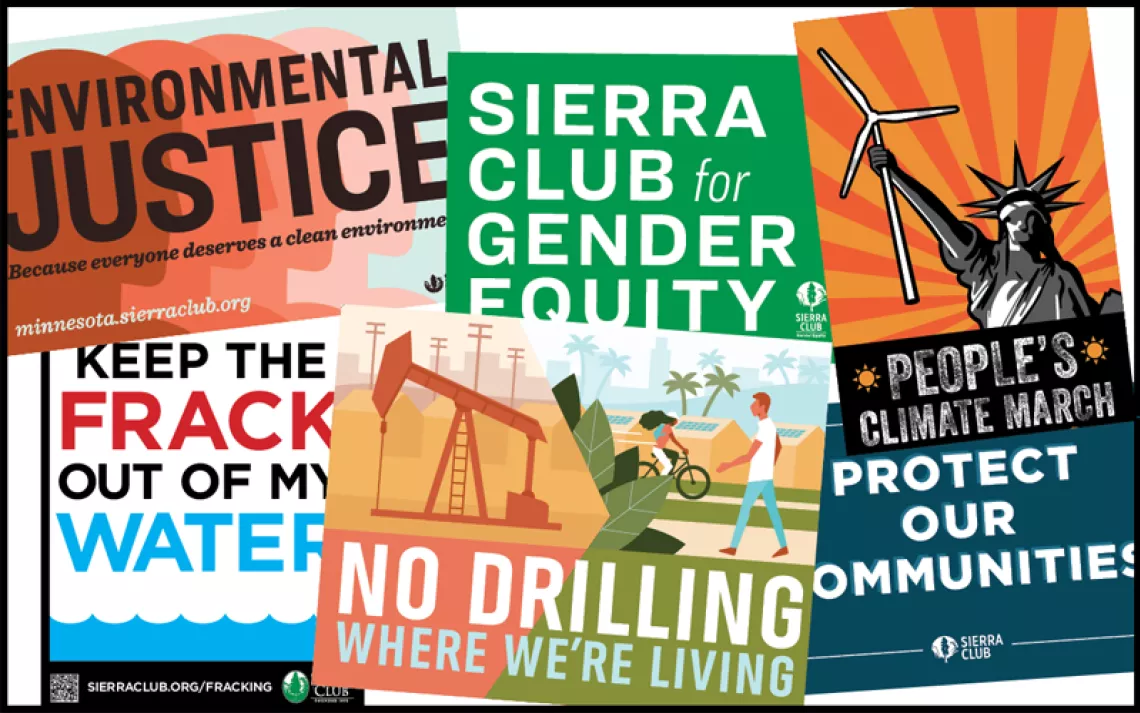The Most Important Environmental Stories of 2023
A year-end roundup of the good and the bad—and some glimmers of hope

Youth plaintiffs in the climate change lawsuit Held v. Montana. | Photo by Thom Bridge/Independent Record via AP/File
The winter solstice has come and gone, and 2024 is approaching fast—and that means it’s time for my annual roundup of the most important environmental stories of the year.
This is a sketch of 2023 happenings that are likely to have a ripple effect well into the future. This year, there was some environmental good news—hopefully enough to provide a bit of year-end cheer and high spirits for what’s to come. But many of these stories, I’m sorry to say, fall firmly in the bummer category.
These aren’t necessarily the environmental news items that grabbed the most eyeballs; often enough, the headlines generate more heat than illumination. And any top 10 list will inevitably have some omissions. This list doesn’t include the horrendous Maui wildfires, the chemical train derailment in East Palestine, Ohio, or the annual United Nations climate talks—all of which received plenty of (well deserved) attention.
Without further ado, here are the biggest environmental happenings of the year that was.

A sign displays an unofficial temperature as jets taxi in Phoenix on July 12. | Photo by Matt York, AP File
1. Hot, Hot Winter, Spring, Summer, Fall
The numbers are in, and meteorologists and climatologists agree that 2023 has been the hottest year on planet Earth since record-keeping began. On nearly every continent and across every season, surface temperatures busted long-standing records—and in the process made it perfectly clear that the era of climate change isn’t some far-off threat but is here upon us now.
Even the winter was hot. In early March, at the depth of the Northern Hemisphere cold season, temperatures in Greenland soared to 50°F above normal. And when the planet spun on its axis to usher in the Southern Hemisphere winter, it was also hot down under as Antarctica posted its highest temperatures ever recorded. Spring was a scorcher in South Asia; temperatures there spiked well into the triple digits, pushing hundreds of millions of people to the edge of their physical limits. Summer came with crippling temperatures in Japan. And in China, the city of Sanbao recorded a high temperature of more than 125°F. By mid-summer, it was clear that the planet had briefly exceeded an average global temperature increase of 1.5°C, the threshold that scientists have long warned about.
Such extreme temperatures are lethal, as environmental journalist Jeff Goodell’s timely bestseller, The Heat Will Kill You First, reminded us. The situation in Phoenix, Arizona, illustrated the point: A torturous, months-long heat wave led to more than 500 heat-related deaths in Maricopa County, the highest number ever. Even fall brought little relief. Global temperatures in September and October obliterated historic records, prompting climatologist Zeke Hausfather to describe the anomaly as “absolutely gobsmackingly bananas.”
While it’s true that the normal cycle of El Niño is forcing temperatures up somewhat, the main driver of this global fever is unmistakable: civilization’s continued combustion of coal, oil, and gas. Greenhouse gas pollution is at an all-time high and, according to the UN, “there is no end in sight.” The brutal fact is that temperatures will continue to rise until greenhouse gas emissions hit zero. Viewed in hindsight—say, 20 years from now—the scorching year of 2023 will likely be seen as cool and comfortable.
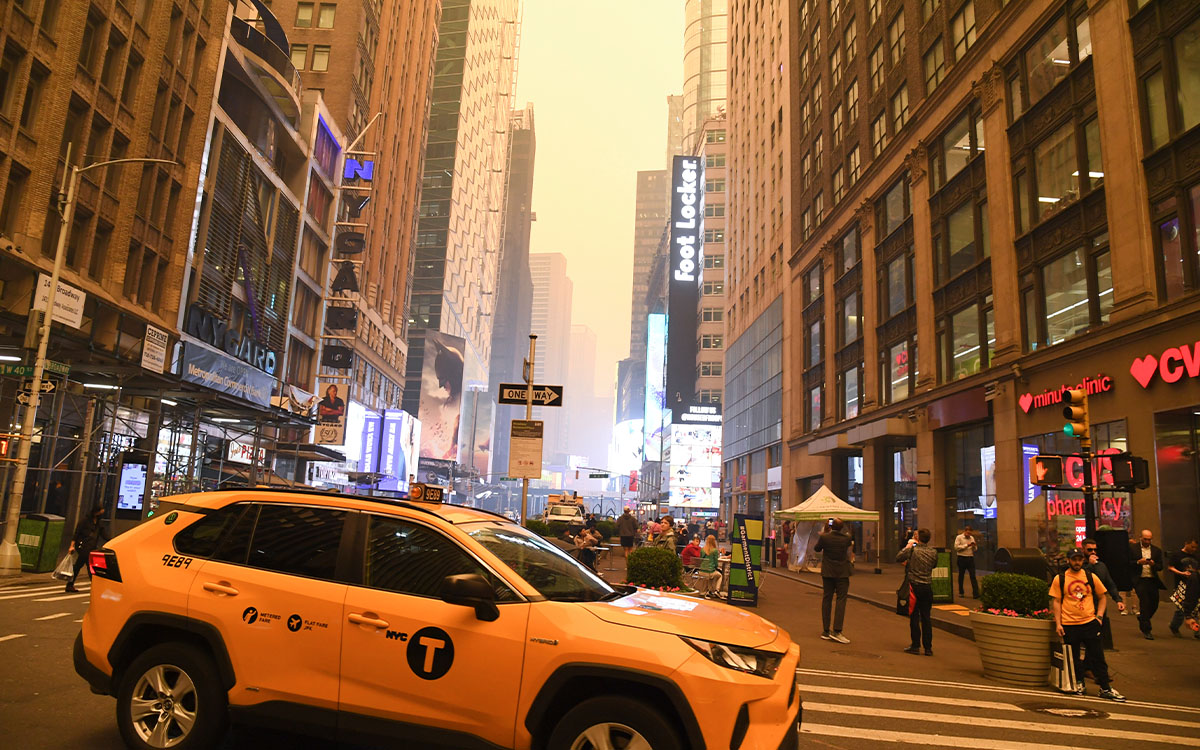
A yellow atmospheric glow is seen as an air quality health advisory was issued in New York on June 7. | Photo by Efren Landaos/Sipa USA via AP
2. Smoke Screen
Unbearable high temps are just one symptom of global heating. As Earth’s atmosphere grows warmer, it warps the entire global climate system and contributes to a range of extreme weather events, including more intense rain and floods, due to the fact that warmer air holds more water. Freakish—and deadly—storms and flooding hit many regions in 2023, from Vermont to central Greece to Hong Kong. But the most dramatic result of burning coal, oil, and gas is that it helps to set other things on fire—most obviously, forests.
While the United States had a relatively mild wildfire season (the tragic fires in Maui notwithstanding), much of Canada was in flames. In 2023, wildfires burned across 37 million acres of Canada. It was the worst fire season in the country’s history, and the conflagrations forced some 200,000 people from their homes.
Where there’s fire, there’s smoke—and in June all of that smoke smothered US cities along the Eastern Seaboard in a sickly, orange pall. On June 6 and 7, more Americans were enveloped in hazardous smoke than ever before in the country’s history.
In recent years, such dystopian events have become all too common in the American West. But many East Coasters seemed genuinely shocked by the apocalypse’s arrival. New York Times columnist David Wallace-Wells predicted the smoke storm would prompt a “perspective shift.” “Until now, if people in the green and leafy Northeast looked at arid Western cities covered in smoke from wildfires, they could say, 'That can’t happen here, thank god.' On Tuesday, it did.”
The smoke storm and the sizzling temperatures delivered a reminder—or, as the case may be, a wake-up call—that there is no escaping global climate change. Wherever you live, no matter how safe and resilient it may seem, climate chaos will somehow make itself felt. There is no away.

Tod Johnson stands in front of his house in South Lake Tahoe, California, a day after the city was ordered to evacuate because of the fast-growing Caldor Fire. | Photo by Terry Chea/AP
3. Home Insurers Warily Eye Extreme Weather
If you needed additional evidence that no place is truly safe from the effects of climate chaos, then look no further than the US home insurance market. In 2023, five major insurance companies—Allstate, American Family, Nationwide, Erie Insurance Group, and Berkshire Hathaway—announced that due to climate-intensified extreme weather events, they are no longer writing policies in some places, will exclude some protections, and/or are increasing premiums and deductibles. This comes on top of the decision by Farmers Insurance to stop writing policies in storm-lashed Florida while also limiting the number of homes it will cover in fire-threatened California.
Insurance companies’ new attention to climate risk is a seismic development. Climate change appears to be on a collision course with that most sacrosanct of American conventions: the 30-year mortgage. As journalist Amanda Abrams reported in Sierra’s Spring edition, there are now real worries that a climate disaster could spark a housing market meltdown on par with the 2008 financial crash.
Insurers’ heightened sensitivity to climate change would seem to be a classic case of a market signal: The companies most focused on risk are sending a clear indication to homebuyers that some places are too risky to underwrite. Yet many people still aren’t getting the message. According to Redfin, more people are moving into flood-prone areas than are moving out of them. The same is true of regions that are susceptible to wildfires or extreme heat, as people continue to flock to homes in what’s called the wildland-urban interface like the Sierra Nevada foothills or else to overcooked, drought-stressed Phoenix.
Yet there are rumblings beneath the surface. In 2022, more than 3 million Americans were at least briefly displaced from their homes due to extreme weather events, and a half million of those never returned home. As journalists like Abrahm Lustgarten and Jake Bittle have demonstrated, some Americans are already looking out at the middle horizon and deciding that they and their families are better off in places that are a bit more climate-resilient though still not immune to climate change. Some Rust Belt cities, for example, are already trying to promote themselves as climate havens; the mayor of Buffalo, New York, has dubbed his city a “climate refuge.”
Watch this space in 2024 and beyond. We are at the beginning stages of a global-warming-fueled great migration.

Youth plaintiffs in the climate change lawsuit Held v. Montana arrive on June 20 for the final day of the trial. | Photo by Thom Bridge/Independent Record via AP/File
4. Youths Score a Climate Victory in Court
Even as billions of people were sweating out the summer of global broiling, some good climate change news arrived. In August, a state court in Montana ruled in favor of 16 young people who had sued the state government, arguing that policies favoring fossil fuels had violated their constitutional right to a clean and healthful environment. The ruling came after a rare courtroom hearing in which the young plaintiffs and expert witnesses were able to make their case for how climate change jeopardizes their well-being. Judge Kathy Seeley agreed, and in her order wrote, “Plaintiffs have proven that as children and youth, they are disproportionately harmed by fossil fuel pollution and climate impacts.”
Although the state has appealed the ruling, the verdict nevertheless marks an important precedent for those who are trying to use the legal system to address climate change. The courtroom triumph may be the first trial win for the public interest lawyers at Our Children’s Trust, but it’s unlikely to be the last. In early December, the innovative lawyers behind the youth-driven effort filed a lawsuit against the Environmental Protection Agency, arguing that extreme heat associated with climate change violates young people’s rights.
The youth lawsuits are just one part of a larger effort to leverage legal power to hold polluters (and enabling governments) accountable for climate chaos. In September, California became the latest state to sue the major oil and gas companies for their unique role in fueling global warming. Given that the Supreme Court has repeatedly declined to intervene in similar cases, it seems just a matter of time before one of the two dozen state and local suits against the carbon barons reaches a trial.
Lawsuits challenging fossil fuel companies and governments for their culpability in the climate crisis aren’t just a US phenomenon. Worldwide, there are some 2,500 climate change lawsuits ongoing—and the phenomenon shows no signs of stopping. In September, six Portuguese youths filed a lawsuit at the European Court of Human Rights, arguing that European governments aren’t doing enough to protect young people from climate change.
Keep an eye on the legal arena—because at some point, whether in 2024 or 2025 or beyond—the perpetrators and enablers of climate destruction are going to be held to account for the greatest crime ever known.

Wind turbines operate as the Northern Lights appear over Ludington, Michigan. | Photo by AP Photo/Ludington Daily News, Steve Begnoche
5. Inflation Reduction Act Blossoms and Grows
In 2022, clean energy dominated the headlines as the White House and Democratic lawmakers maneuvered to pass sweeping energy and climate legislation—the Build Back Better Act, which eventually morphed into the Inflation Reduction Act. The political machinations were made for the media maelstrom, what with all the intrigue, big personalities, and the last-minute compromise between Senators Chuck Schumer and Joe Manchin that snatched victory from the jaws of defeat.
This past year, the advance of federal clean energy policy didn’t make as much news. Yet this unglamorous work is undoubtedly among the most important environmental stories of 2023, as the steady, yeoman-like implementation of the IRA has put the United States firmly on the path toward decarbonization.
In a nutshell, the Inflation Reduction Act is working as intended, and even exceeding the expectations of its architects. Already, the law is a job creator. Since its passage, the IRA has helped create 176,000 clean energy jobs in the United States. This includes jobs in 91 new battery manufacturing sites, 65 new or expanded electric vehicle facilities, and 84 new wind and solar manufacturing plants. Companies are rushing to cash in on the federal clean energy incentives, so much so that the final investment figure is likely to bust through original estimates. One analysis forecasts that, ultimately, the law may deliver to companies up to $1 trillion in tax incentives, credits, and other rebates.
And the law’s implementation is proving to have an interesting political lining: Much of the clean energy boom is happening in red states, or at least purple ones. Georgia tops the list for the most clean energy manufacturing investments since the law’s passage, and South Carolina isn’t far behind. When it comes to the most clean energy jobs created in the last year, Tennessee is number one, and Kentucky is number two. The celebrated Battery Belt is largely clustered in the South.
In the short term, this explosion of green jobs in red states has put many Republicans in a weird position as they find themselves celebrating a law they didn’t vote for. In the long run, this industrial renaissance and the concentration of clean energy jobs in conservative states opens up the possibility of a fundamental realignment in American politics. Every clean energy job helps to create a clean energy voter and, over time, this burst of industrial activity will create a political constituency committed to renewable energy. Someday soon-ish, the clean energy industry will no longer seem like an idea climate advocates cooked up. It will be, simply, business as usual.
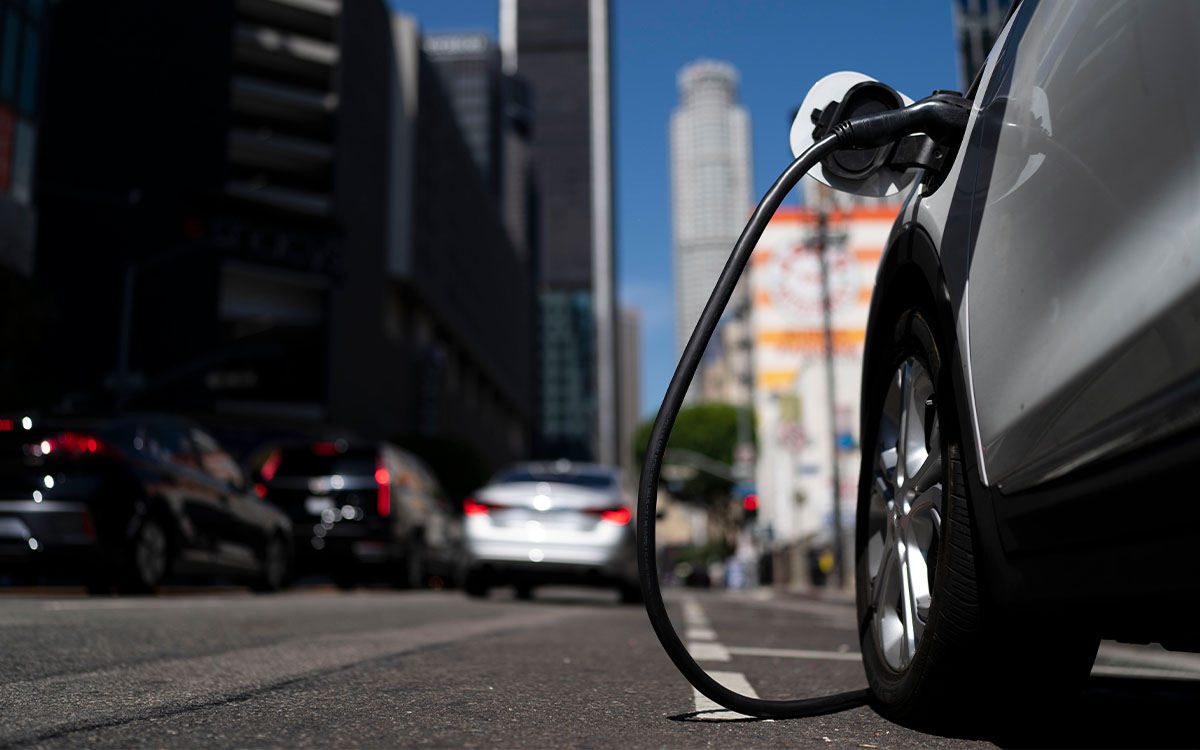
An electric vehicle is plugged into a charger in Los Angeles, California. | Photo by Jae C. Hong, AP File
6. EVs Keep Accelerating
This fall, a lot of reporters spent a lot of time wringing their hands about a supposed slowdown in EV sales (see, if you must, here and here and here). The Economist wondered: “Is America’s EV revolution stalling?” Short answer: Not really.
The media take on electric vehicles was like the automotive version of the vibecession. Yes, there have been some bad vibes in the EV space, but a close look at the underlying fundamentals reveals that the EV market in the United States, and globally, continues to grow. Or, as Princeton professor Jesse Jenkins summed it up, “The vibes are bad—but the data is great.” According to data from RMI, global sales of internal combustion cars have already peaked—and, in fact, likely did so as far back as 2017.
In the third quarter of this year, sales of battery electric and plug-in hybrids in the United States hit their highest level ever and accounted for 17.7 percent of all light-duty vehicle sales. By the end of this year, US sales of pure EVs and plug-in hybrids are expected to hit 1.4 million automobiles—another record. Sales of pure EVs are on track to reach 9 percent of all US auto sales—a number that was unimaginable just a few years ago. According to Jenkins, the year over year growth rate of EVs is fast enough that EV sales should double every 14 months. And EVs will become even more attractive to buyers starting January 1, when eligible consumers will be able to get their $7,500 rebate at the time of purchase, since nothing sweetens a deal like cash on the hood.
The global picture is even more encouraging. EV sales in China, by far the world’s largest auto market, continue to hit record numbers even as long-standing government subsidies expire. In Europe, EV sales in the first nine months of the year increased 47 percent compared with 2022 numbers.
Let’s not be Pollyannaish, though. The hurdles to electric vehicle adoption are real. Many models remain too expensive for working families; high interest rates are a drag on sales; and most of the early adopters have already bought their EVs. Some manufacturers, especially boutique ones like Rivian, are now facing the so-called Valley of Death—the inflection point at which they need to make a leap from the early adopters to ordinary car buyers.
In spite of all that, the long-term trends continue to be encouraging. The heyday of the internal combustion engine is over; the age of the electric vehicle is fast approaching. We are at the stage of awkward and uncomfortable growing pains. But the ascendance of electric vehicles is inevitable—the only question is whether it will unfold fast enough to avoid the worst consequences of climate change.
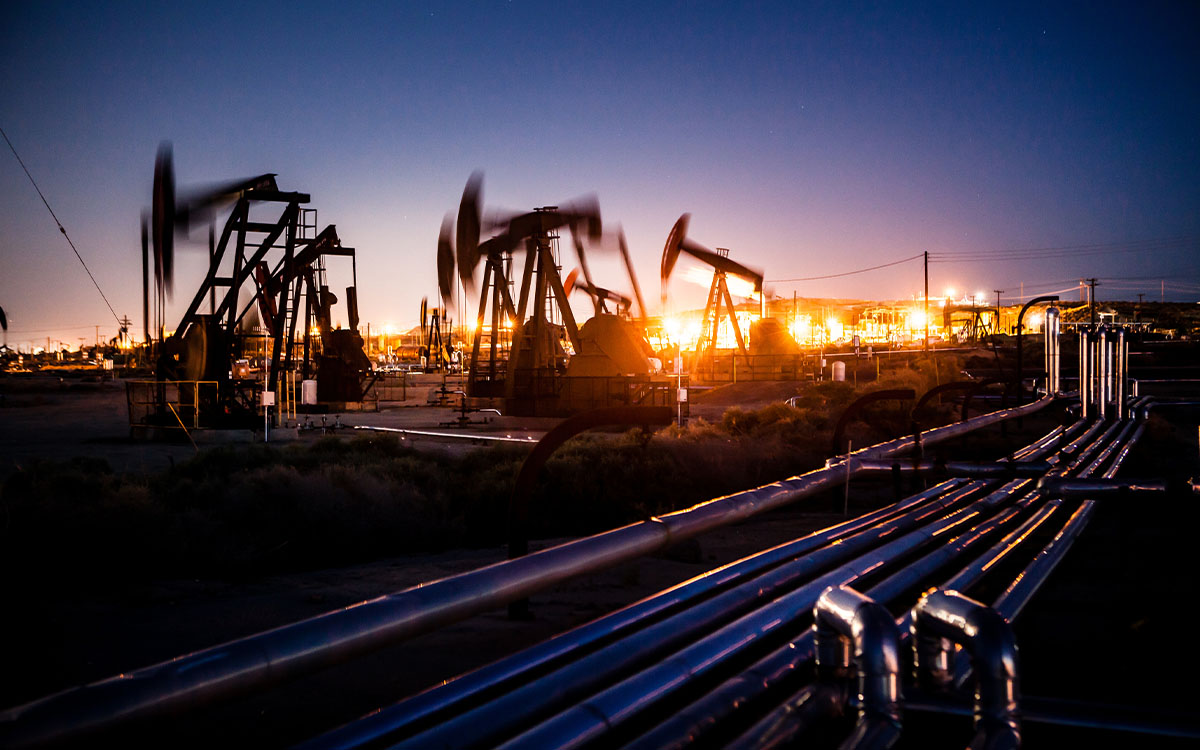
Oil pumpjacks in Kern County, California. | Photo by Gary Kavanagh/iStock
7. US Continues to Drill, Baby, Drill
The surge of US clean energy production and the steady sales of electric vehicles may be an unalloyed good—yet those gains are being undermined by the fact that American fossil fuel companies (and their accomplices in state and federal governments) are showing no signs of slowing down oil and gas drilling. In an ideal world, all those renewable-energy electrons would be substituting for dirty energy, leading to a subtraction of fossil fuels. Instead, what we’re experiencing is more like addition, as both clean and dirty energy grow.
In 2023, US petroleum production hit a record high as oil companies produced 13.2 million barrels of planet-roasting crude oil daily, every barrel of which, The New York Times explained with impressive understatement, threatens “to undercut efforts to reduce greenhouse gas emissions.” Gas production is also going gangbusters. Extraction of methane gas—which is 80 times more heat-trapping than CO2 in the near term—obliterated the record set just last year.
What makes this especially maddening is the fact that many of these hydrocarbons are destined for export; about one-fifth of all US gas is sold to other countries. Now, US gas producers—awash in a glut of methane from the fracking fields—are determined to produce and export even more of the fossil fuel, and they are pushing for a string of new liquefied natural gas (LNG) terminals along the Gulf Coast. This would be nothing short of a climate disaster: If all the proposed LNG terminals are built, it could virtually wipe out the US greenhouse gas reductions of the past 20 years.
All of which presents a major test to the Biden administration, which will have to choose whether to greenlight more gas exports. The recent UN climate talks ended with an agreement to “transition away from fossil fuels in energy systems, in a just, orderly and equitable manner.” That transition must, inevitably, begin with governments saying no to any new fossil fuel infrastructure. The LNG build-out is a perfect place to start.
Environmental justice groups and climate activists continue to contest the oil and gas boom with all the tools at their disposal. In 2024, you can expect this opposition to intensify. This decade, the fight against oil and gas exports—and especially the LNG terminals—is poised to become for the US climate movement the equivalent of the Keystone XL and Dakota Access Pipeline battles of the 2010s.

Huaorani people (Waorani or Waodani, also known as the Waos) from the Amazonian region of Ecuador. | Photo by Ondrej Zaruba/CTK via AP
8. Ecuadorians Vote to Leave Oil in the Ground
If US political leaders are looking for an example of the political courage required to leave oil reserves in the ground, they should look to Ecuador, where voters in August approved a national referendum to halt any future oil drilling in Yasuní National Park.
It’s hard to overstate how historic the vote was. Even as other oil-rich nations with supposed environmental bona fides struggle to cut themselves free from oil (yes, looking at you, Norway), Ecuadorian voters took the unprecedented step of willingly forgoing the profits to be made from oil extraction. Ecuadorians decided that the damage was not worth it, no doubt aware of the long history of water pollution, environmental destruction, and human rights abuses associated with oil extraction in the Amazon region. The final vote total was a blowout, as some 58 percent of voters cast a ballot in favor of the drilling ban. “Finally, we are going to kick oil companies out of our territory! This is a major victory for all Indigenous peoples, for the animals, the plants, the spirits of the forest and our climate,” Nemonte Nenquino, an Indigenous Waorani leader and winner of the Goldman Prize, told The Guardian.
Ecuadorian voters demonstrated exactly the kind of vision and commitment that will be necessary to turn away from fossil fuels. To date, more than a dozen national governments have endorsed the call for a Fossil Fuel Non-Proliferation Treaty. But many of them are small island nations without significant oil, gas, and coal reserves. To truly transition away from fossil fuels will ultimately require that countries with significant fossil fuel resources—Australia with all its coal, the US with all its oil and gas, Canada with all of the above, and of course the Middle East petro-states—follow the lead of Ecuador and voluntarily commit to leaving fossil fuels in the ground. With their vote this summer, the people of Ecuador have shown that not only is this doable but also it can be politically popular.
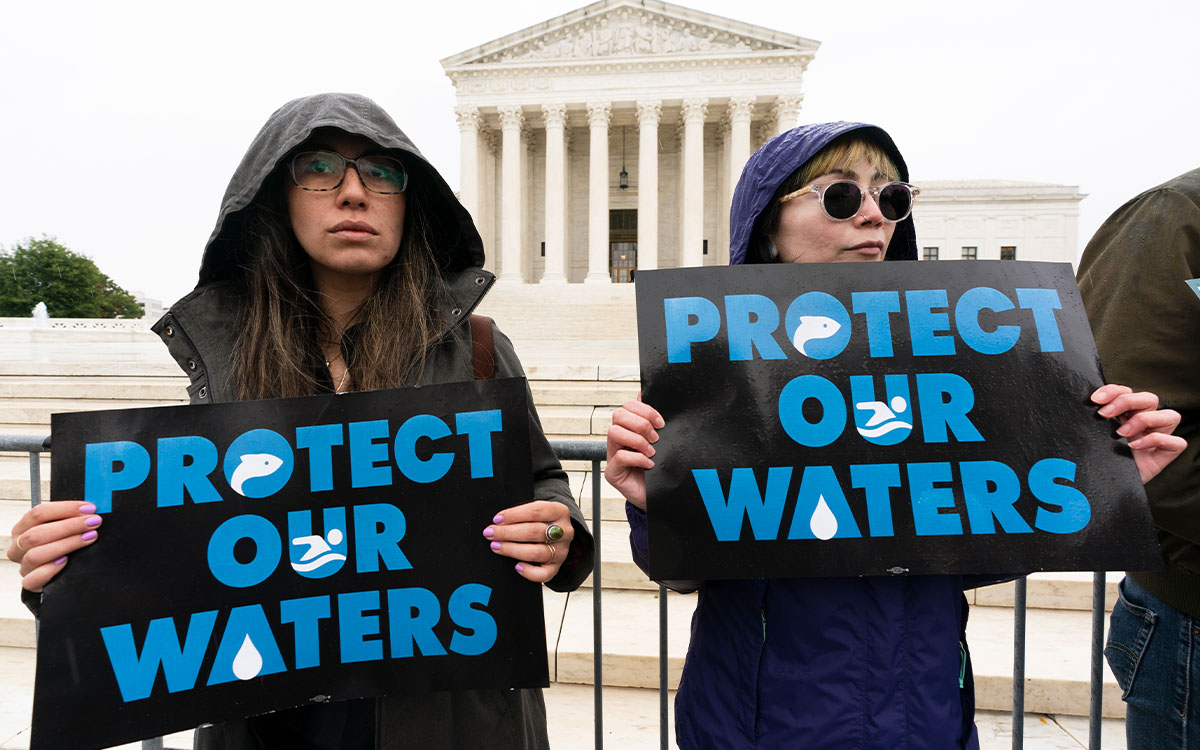
Mika Hyer and Roxana Amaya-Fuentes, right, join supporters of the Clean Water Act gathered in front of the Supreme Court. | Photo by Manuel Balce Ceneta/AP
9. US Supreme Court Dilutes Clean Water Act
Apologies, but a bit more bad news. In 2023, the Supreme Court continued its steady assault on the federal government’s ability to safeguard the environment when it ruled to significantly water down the Clean Water Act—a pillar of US environmental law.
The case of Sackett v. EPA largely hinged on a fine point of law—how to define a “wetland,” and whether natural features like bogs and swamps need to be contiguous with lakes, rivers, and streams in order to enjoy the protections of the Clean Water Act. In its decision, the court ruled that wetlands are not covered by the law, as they have been for decades. If this seems like no big deal, consider this: Ephemeral streams, wetlands, and fens comprise some 50 million acres of the United States. Such natural features deliver crucial ecosystems services. They filter and clean water; provide buffers against storm surges; and swallow carbon dioxide. They also provide homes to countless other living creatures.
While the justices didn’t go as far as the plaintiffs and the right-wing legal outfits representing them wanted—which was a wholesale demolition of the Clean Water Act—environmental legal experts cautioned that the majority’s decision is by no means a middle ground position. The ruling puts tens of millions of acres of wetlands at risk from development or pollution. And Sam Shankar, an attorney with Earthjustice, warned that the court’s ruling was the “fruition” of a “decades-long push by … industries” to slash commonsense environmental safeguards.
Expect that decades-long push to continue in 2024. This coming January, the justices will hear arguments in a pair of cases that touch on the very ability of the executive branch to implement laws written by Congress. Despite being pummeled by scandals and experiencing a huge decline in public confidence, the Supreme Court’s conservative super-majority seems as determined as ever to keep slashing and burning US environmental law.
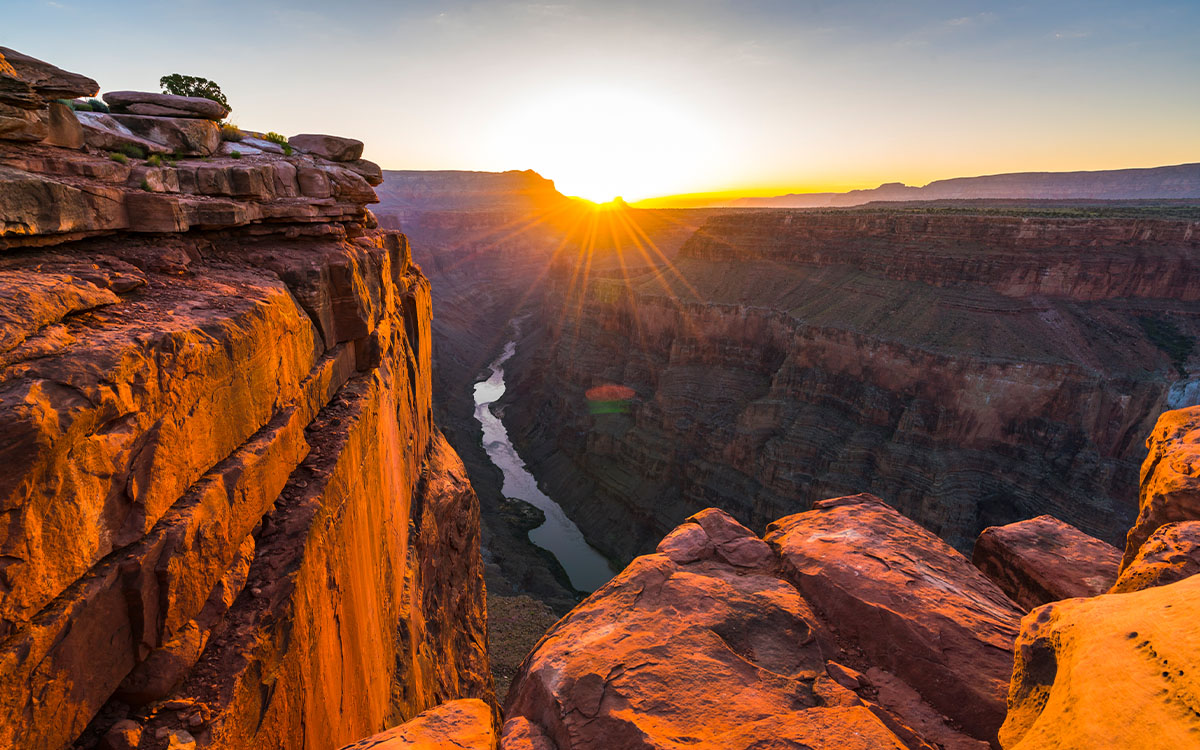
Toroweap Overlook at sunrise in Grand Canyon National Park. | Photo by Joecho-16/iStock
10. Biden Creates New National Monuments
Let’s end on a high note. This past year, the Biden administration took some important steps to protect lands, waters, and wildlife as President Biden used his authority under the Antiquities Act to create several new national monuments—just one part of a larger administration effort to safeguard wildlands and the critters that call them home.
In March, Biden established the Avi Kwa Ame National Monument (a.k.a. Spirit Mountain) in Nevada. Many Native American nations hold this corner of the Mojave Desert sacred, and it’s also home to endemic species like bighorn sheep. The half-million-acre monument will also link together other public lands in the Southwest, in the process knitting together a vast wildlife corridor. At the same time, Biden created the Castner Range National Monument outside of El Paso, Texas.
Biden’s biggest land-protection move came in August, when the president created the Baaj Nwaavjo I’tah Kukveni-Ancestral Footprints of the Grand Canyon National Monument. The designation will provide new safeguards to nearly 1 million acres surrounding the Grand Canyon by prohibiting new mining claims in the area, among other protections.
A cohort of Republicans has recently joined a lawsuit asking the Supreme Court to review the Antiquities Act. If congressional Republicans don’t like the president creating national monuments, they can, of course, take matters into their own hands. Congress should pass the proposed bills—many of which have bipartisan authors—to create or expand various national parks and wilderness areas.
In the meantime, the Biden administration should—and no doubt will—continue to use its executive authority to protect lands, waters, and wildlife. In 2023, the Biden administration issued draft rules that would have the Bureau of Land Management put lands-conservation on a par with extractive uses like logging, mining, and grazing—a move that would protect tens of millions of acres. The White House called for decommissioning dams on the Lower Snake River in Washington State in an effort to restore salmon populations. The US Fish and Wildlife Service moved to strengthen enforcement of the Endangered Species Act. And just this week, the Forest Service announced new management guidelines to protect mature and old-growth forests.
This kind of progress may slip beneath many people’s news radars, but President Biden is beginning to distinguish himself as one of the most successful conservation presidents in modern history. You can expect that in 2024, the administration will continue to do whatever it can to protect wildlands and wildlife—and that should make for some more happy headlines by this time next year.
 The Magazine of The Sierra Club
The Magazine of The Sierra Club
